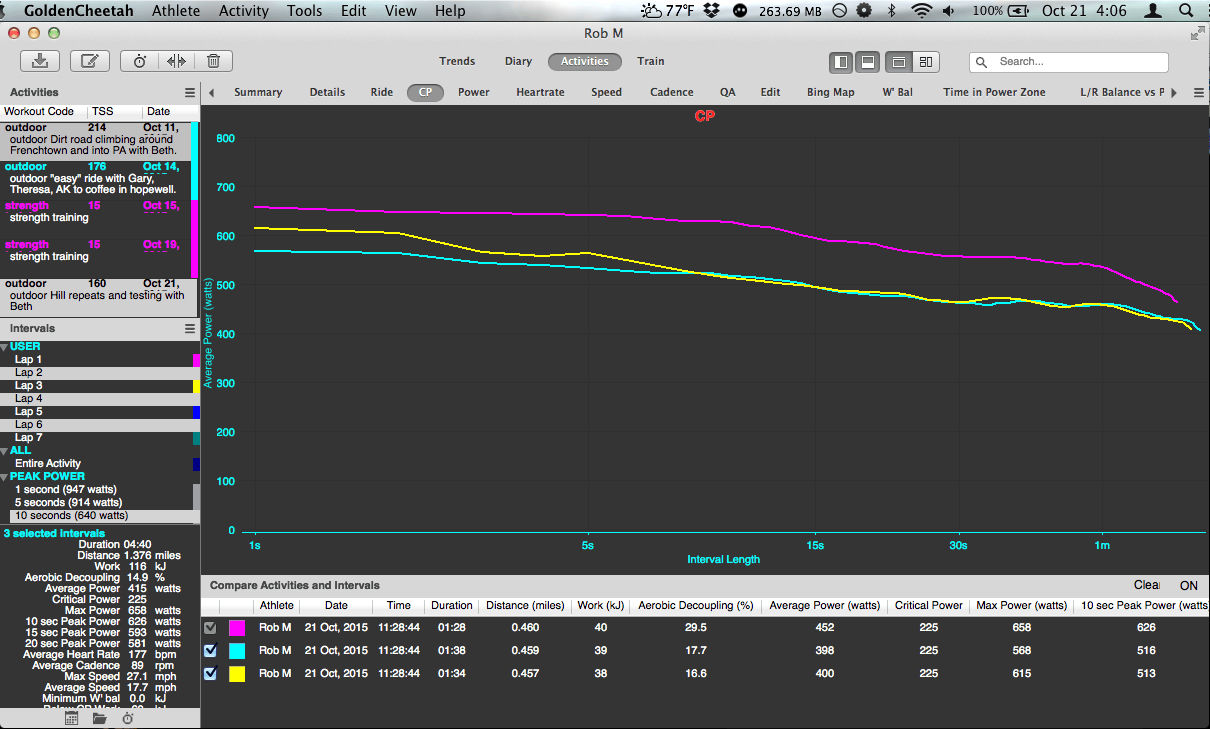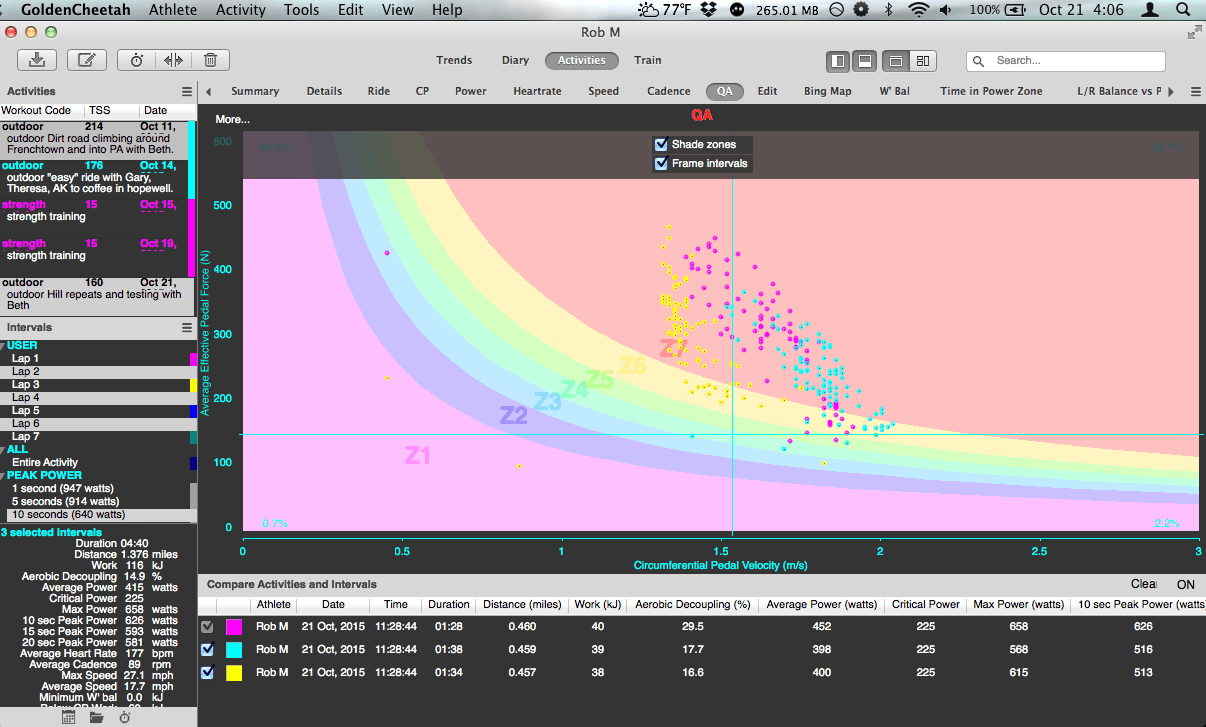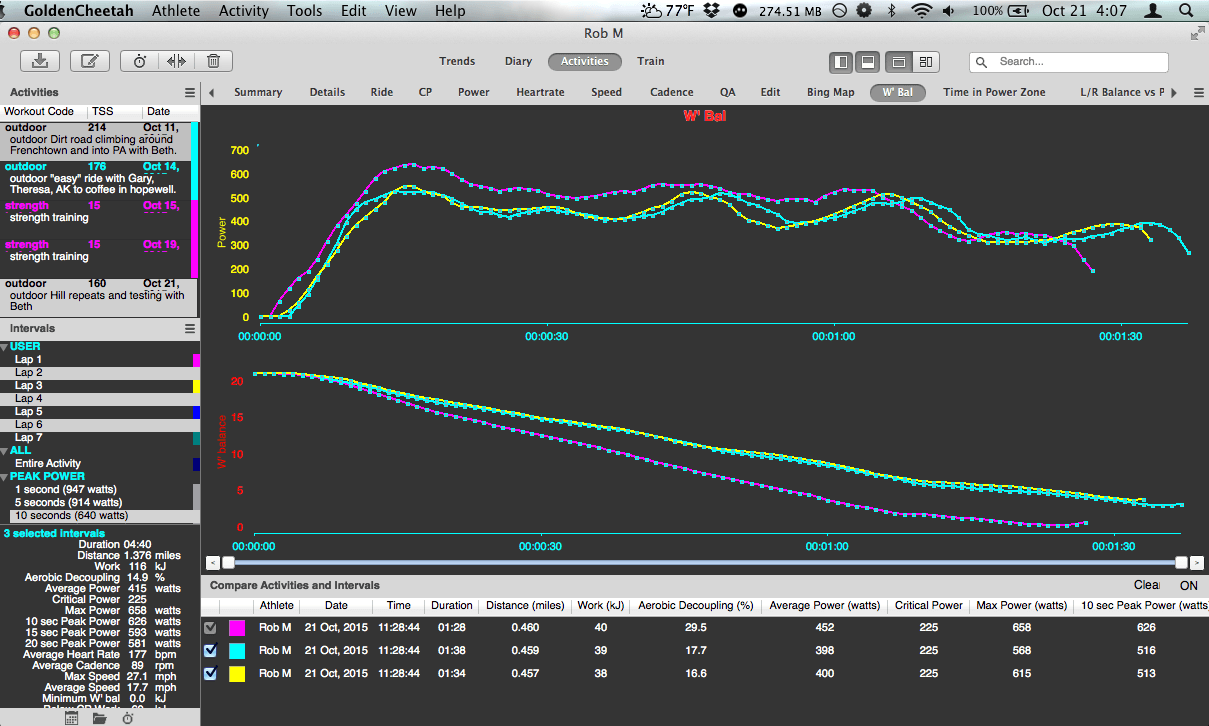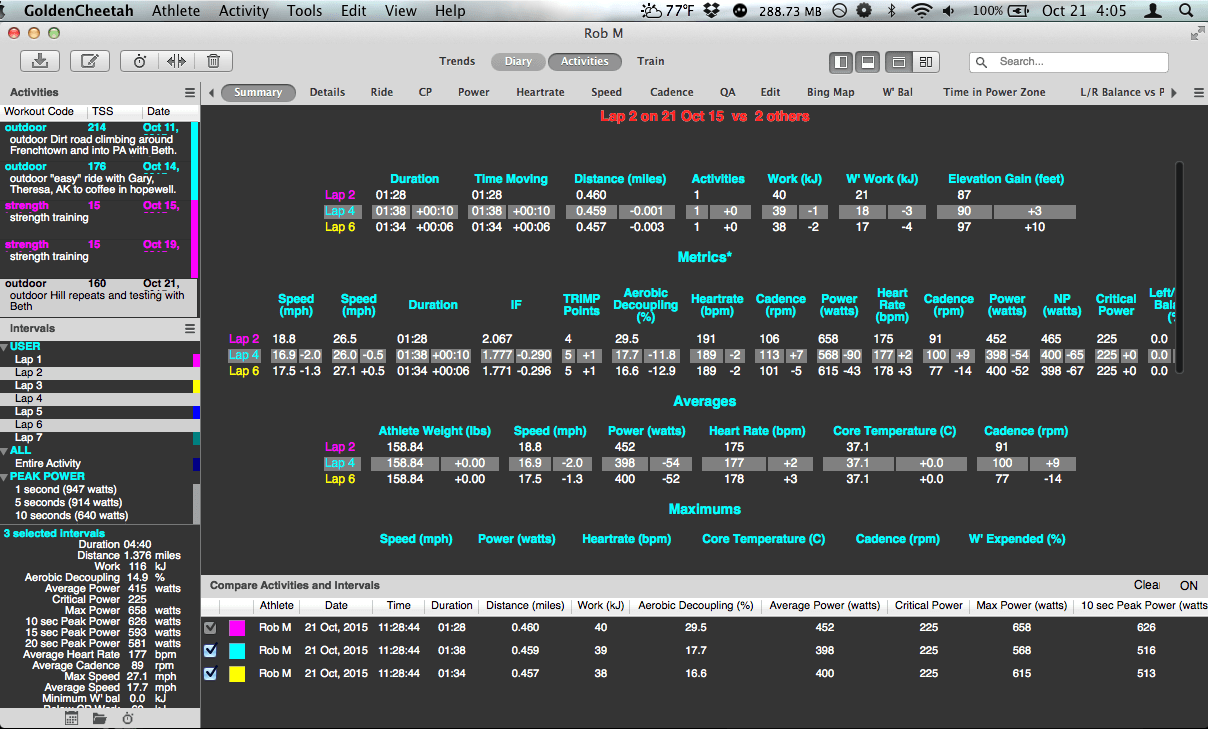I can't tell you how many times cyclists contact me and ask me to help them improve their climbing weakness, but they don't even know what climbing weakness is holding them back! Do you climb better in the saddle or out? Are you more efficient at a lower cadence or higher? Do you tend to go out too hard and burn out too quickly? Are you leaving speed on the table by being TOO conservative? These are all questions you can answer if you're willing and able to head out, do a couple of laps of your favorite climb and sit down to take a look at your data.
Let's figure out how to find your climbing weakness and correct it! Click through for my best tips on determining what's limiting your climbing capacity and a couple ways to correct it?
Testing For Your Climbing Weakness
- Find a loop around you with a climb on it. Between 4 and 6 minutes of climbing would be ideal, but you can work with anything over 2 minutes in length. The loop should be long enough that you can adequately recover after each climb.
- The first time through the loop, do as much of the climb (all of it would be ideal) while seated on the saddle.
- The second time through the loop, climb out of the saddle as much as you can.
- If you are able to repeat the loop a third time, mix it up and stand when you hit a steep part, sit during a shallower part.
- Compare your climbs using Strava, Golden Cheetah or WKO+. See which was the fastest and compare how you climbed the best.
If you're able to repeat this test a couple of days later and switch up the order in which you ride the climb (standing first, then riders choice, then all seated) you'll find your data is much better and you can correlate it better.
Once you're done analyzing your loops, you'll probably find that you climb better either in the saddle or out, not necessarily both. Once you've determined what your fastest climbing method is, you can take steps to strengthen the other one, your climbing weakness.
Analyze Your Results
Once you have your data, you need to start thinking about analyzing it. You're going to want to look at your data and find out which method you climb the fastest, which method is the most efficient, do you have any “bad habits” that you should be aware of and where can you improve upon your efforts?
To find out which method you climb the fastest, simply look at the overall time for each interval (compare the distance too to make sure you're on point.)
To find out efficiency, look at energy expended vs time climbing as well as aerobic decoupling.
To figure out your bad habits, look at a graph of speed, W' or the like to see if you have any points where you slow down or die off.
To figure out where you can improve, look at all the above and pick the weakest. It's a good bet that is your climbing weakness, and working through it may be your ticket to improvement.
If you want a more in-depth example of how to apply these principles, let's take a more detailed look at some of the values from one of my testing sessions. I'll evaluate the metrics and find out where I can improve my own climbing weakness at the end of a season plagued by injury and lack of riding.
First off, we compare the 3 major work intervals that were performed. In this case, magenta (lap 2) will represent a combined effort of seated and standing climbing, or the “choose what feels the best” option. Cyan (lap 4) will represent seated only climbing, and yellow (lap 6) will represent only standing climbing.
Looking carefully at the data, you can see that lap 2 (the mixed climbing) was the fastest by about 6 seconds. Out of the saddle climbing came in second fastest, while seated climbing only was the slowest. You can also note a couple of things here as well:
- The mixed technique climbing used the most energy (obviously, being the fastest) but it also used the most W' or anaerobic energy. You can see this on the top rows, under “Work (kJ)” and “W' Work (kJ)” This will have implications described below.
- Mixed climbing has the highest aerobic decoupling and highest maximal heart rate (yet the lowest average HR. This is because HR lags behind power production in terms of response.)
- Standing climbing was the second fastest, yet it cost the least energy (see the chart above) AND had the lowest aerobic decoupling (indicating high efficiency while out of the saddle.)
So what does this mean?
Let's take a look at some CP charts and see what those tell us:
 These graphs show us what we already know, but they also give us a little additional insight. For example, it shows that during the first effort, power declined rapidly after the 1-minute mark, intimating that perhaps too much energy was expended initially. Conversely, there was little drop off with both the seated and standing intervals.
These graphs show us what we already know, but they also give us a little additional insight. For example, it shows that during the first effort, power declined rapidly after the 1-minute mark, intimating that perhaps too much energy was expended initially. Conversely, there was little drop off with both the seated and standing intervals.
How do we get some data on efficiency and how we perform at different kinds of climbing? Look at a quadrant plot, that's how.
 The quadrant analysis shows us that overall, the standing interval was the most “even” in terms of cadence. The seated interval has more spread (and a much greater spread of force numbers) while the mixed interval has the widest spread of cadences and force production numbers. Fundamentally, it shows that there's a little more efficiency in the standing drills here.
The quadrant analysis shows us that overall, the standing interval was the most “even” in terms of cadence. The seated interval has more spread (and a much greater spread of force numbers) while the mixed interval has the widest spread of cadences and force production numbers. Fundamentally, it shows that there's a little more efficiency in the standing drills here.
Finally, let's take a look at power and W' to see what can be improved upon.
Looking at the top graph (the power graph) you can see the mixed climbing interval had the highest overall power, but the power drops off significantly faster near the end of the interval. By looking down at the W' graph, you can see that the W' drops significantly, going under 25% for the last 1/3 of the interval. This shows that during the mixed interval, I went out too fast and faded hard by the end of the interval. In terms of the standing and seated intervals, they're pretty even overall.
So what did we learn from all this analysis? We learned there's a tendency to go out too hard when choosing to sit or stand at will. There's an overconfidence when jumping out of the saddle (since most of the time we don't feel an effort until it's well and truly too late. We also learned that standing out of the saddle was not only faster, but more efficient in this case. Seated in the saddle, while it should be the most efficient method of climbing, was not as good as standing.
Now, there's some thought that the seated interval was nearly as fast for lesser power so it should be more efficient, right? Well, no. It used MORE W' kJ, more kJ in general, and greater aerobic decoupling compared to the standing only interval.
Knowing that the slowest climbing method is seated in the saddle, how can we adjust for that and work on improving?
Attack Your Climbing Weakness
So now you've gone and ridden a bunch of hill repeats (and you probably hate me for it) and you've got this data that shows how you climb well and how you climb “not so well.” How do you fix the “not so well” so you can be a better climber?
If you found during your analysis that standing up out of the saddle is slower, you're probably lacking a little bit of pop in your climbing. Climbing out of the saddle is also a lot more taxing on your cardiovascular system and your muscular system because you have to support your upper body while out of the saddle. Here's how you train to be a better out of the saddle climber:
- Muscular Endurance: Blocks of low cadence, high pedal tension work in the saddle will make your muscles more fatigue resistant and help to convert all your off-season strength training into cycling power. Aim for 40 minutes overall per workout of high tension, low cadence (~70 RPM) work. Intensity should be between sweet spot and FTP, depending upon the time of year. Variations include 60 RPM work for shorter blocks but significantly harder intensity.
- Standing Drills: To condition your muscles (and your cardiovascular system) to handle climbing out of the saddle better, you can shoot for several blocks of standing drills. Your intensity should be around threshold (or slightly above) with a comfortable cadence. Increasing your cadence will put more stress on your lungs, while dropping it lower will tax your muscular endurance more. Shoot for 10-12 minutes of standing work per session to improve your standing capability.
- Core Stability: It should come as no surprise that you need to have solid core strength and stability if you're going to be jumping out of the saddle frequently. Use a variety of core strength and stability exercises a couple of times per week to stabilize your core or take a look at my Unbreakable Core Stability training module.
- Track Starts: If you lack the ability to accelerate against heavy resistance, you'll struggle when the road pitches steepen and you have to accelerate over them or maintain some tempo on that steeper incline. Practice accelerating under tension by rolling to a near stop and then standing up and accelerating a big gear (think 53/14 or 50/12) from that near standstill. You can do these on any terrain, from hills to flats to headwinds. Aim for 5 reps of about 10 seconds each during your workout to build that explosive punch.
- Muscular Endurance: Just as with standing as a weakness, blocks of low cadence, high pedal tension work can help to make your muscles fatigue resistant and allow you to put more power into the pedals. Shoot for 40 minutes total of low cadence, high tension work.
- Functional Threshold Power: If you want to climb better in the saddle, you'll need to rely on your aerobic system a little more than brute power, soincreasing your FTP is a necessity. You'll want to knock out two 20 minute blocks of FTP work in a session. You can do these on the flats or on climbs, but above all, make sure you ride them at your climbing cadence so you can get used to the feeling.
- Neuromuscular Efficiency: The more coordinated and more efficient your muscles contract, the less energy they'll use to do the same amount of work. To build efficiency and increase neuromuscular coordination, get some superspin work in. Aim for 5-7 one minute blocks during which you practice spinning a smaller gear at 120+ RPM (basically as fast as you can spin without bouncing in the saddle.) You can also do these intervals on descents, spinning a bigger gear as fast as you possibly can downhill. For something different, consider doing spinup work, where you use the track start protocol above, but instead of a big gear you'll want to use a smaller one (think 53/18 or something bigger.)
- Core Stability: As much as or maybe even more than when you're out of the saddle, your core stability is important to tie your upper body and legs together. “Rowing” the bike or pulling back against the bars while climbing in the saddle is a great way to add power to your pedal stroke, but you can't do it if you're weak through your core: all that motion is lost energy instead of power put to the pedals. Again, a couple times per week, perform a core/stability routine or take a look at my Unbreakable Core Stability training module.
Now you have some information on how to attack your climbing weaknesses and stop them from being your limiters when the road tilts upward. If you're still not sure, you can check out my previous podcasts Climb Like A Pro – Part 1, Part 2 and Part 3. If you're not seeing the results you want, you can always shoot me an email, or take a look at my downloadable training plans which will incorporate all these concepts.
Don't forget to share and like this post!


